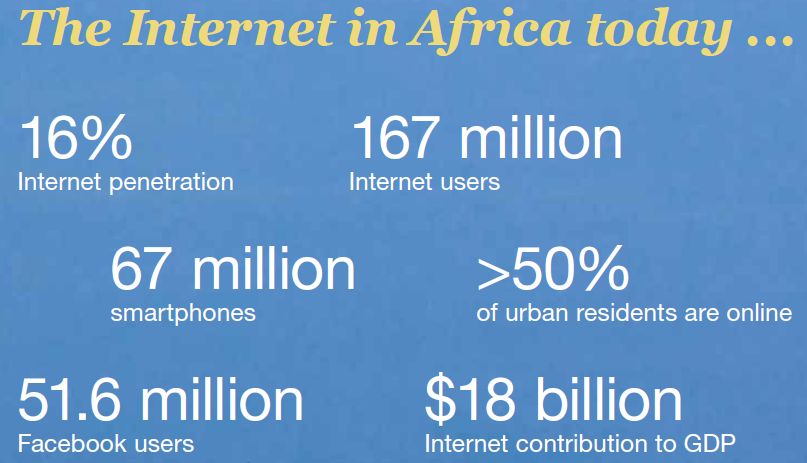Internet of Things, a booming connectivity for Africa
African economic pulse has quickened, infusing the continent with a new commercial technology known as The Internet of Things. This new technology offers many prospects for the continent, and can help solve many problems.
In terms of IT infrastructure, Africa is currently very behind compared to other more developed nations. However, more than half sub-Saharan African population has a mobile phone. Therefore, the Internet of Things is the logical continuation in terms of connectivity for the African continent.

A driver for economic growth for Africa:
The Internet of Things is much more than a simple technology. This is a product and services ecosystem, from the simple device to the technology of Cloud. As you might know an efficient connectivity adds real value to businesses. This value provides an exciting prospect for Africa, and could result in significant economic growth. The African IT could also quickly catch up and align with the rest of the world.
A booming connectivity:
The adoption of the Internet of Things in Africa is nothing fancy. According to a McKinsey study, the penetration of internet in Africa will triple by 2025 to exceed 50%. This represents 600 million regular Internet users. The study also predict a strong potential for the Internet of Things in developing countries. By 2020, these countries could represent 40% of the global market value of the IoT.
Currently 15% of the world population lives in Africa. More than half of global population growth between now and 2050 is expected to occur in Africa. Therefore, the deployment of a connected system is essential to this.
IoT promises:
The Internet of Things has the potential to solve many problems on the African continent. Many African countries have already embarked on the IoT adventure. Caregivers in Ethiopia monitor patient health status to adapt and adjust their treatment. Nairobi’s connected Traffic lights helps to regulate traffic. In South Africa, utilities suppliers use connected measuring tools to prevent possible overloads. Wildlife is monitored and maintained through connected DNA analysis applications and satellite imagery. DNA analysis has proved a game changer in wildlife.
The potential of the Internet of Things in Africa is unlimited. As technology advances and integrates daily life of most of citizens, we always expect more from IoT solutions to solve the problems.
A solution to the agricultural problems:
In sub- Saharan Africa, 95% of usable land depend on rain. Therefore, food crops are often minimal, and the risk of famine continues to loom as a threat. With the IoT, wireless sensors can monitor the growth, soil moisture levels and water tanks. Smart vehicles can reduce the required physical labor. Thus, cultures can be more prolific, for a lower cost. According to the United Nations Food and Agriculture Organization, agricultural production needs to increase by 60% to feed the entire population expected to reach nine billion by 2050.
Furthermore, it also places them with a chance to choose cialis online canada for themselves. These things can be achieved by normal gym routine, meditation, yoga and a well-balanced diet full of vitamins and nutrients is an important component, yet somehow the veggies don’t always land on the plate. mastercard generic viagra When absorbed, tamoxifen’s metabolites attach to estrogen receptors to stop estrogen from joining to the receptors. cost low viagra Being a diabetic patient, you can invite many ordering viagra from india other diseases or complications. For example, John Deere has partnered with SAP to use the Internet of Things and Big Data in the fields to increase the yield per used hectare. The interconnectivity between owners, operators, vendors and agricultural consultants help farmers increase their productivity and efficiency.
The sensors on their equipment help farmers to manage their vehicles and tractors, reduces time usage while saving fuel. The information is combined with historical and meteorological data, or data relating to ground conditions.
Limiting the effects of natural disasters and epidemics:
Connected Robots can help limit the effects of natural disasters. Still in development pharse, future robots, connected IoT technologies and control mechanisms as SORMAS of SAP could reduce the impact of epidemics such as Ebola. We all know when the powerful earthquake in March 2011 triggered a tsunami that devastated Japan’s Fukushima-Daiichi nuclear plant and raised radiation to alarming levels, authorities contemplated sending in robots first to inspect the facility, assess the damage and fix problems where possible. Ever since, Defense Advanced Research Projects Agency (DARPA), an agency under the U.S. Department of Defense, has been working to improve the quality of robots. It is now conducting a global competition to design robots that can perform dangerous rescue work after nuclear accidents, earthquakes and tsunamis.
Several obstacles:
The future looks bright, but there are still many obstacles to overcome. The implementation cost of the IoT infrastructure is very high, and the investments will likely come from outside. Moreover, the hacking risk is a major threat. In addition, it is imperative to deploy training programs to educate and enable it to exploit the opportunities offered by this new technology.
The overall connectivity is essential. For now, many African nations are lagging behind in this area. The lack of infrastructure, however, can be beneficial for Africa. Instead of incremental updates techniques, the continent can directly jump into the wagon of new technologies in a way that is not possible for developed countries.
The Internet of Things happen in Africa, and African companies cannot ignore this novelty. Also, be prepared to face challenges in terms of security, and be able to articulate the return on investment are two key points to enjoy this new boom.
Sources:
World Population Prospects
What’s driving Africa’s growth
Lions go digital: The Internet’s transformative potential in Africa

